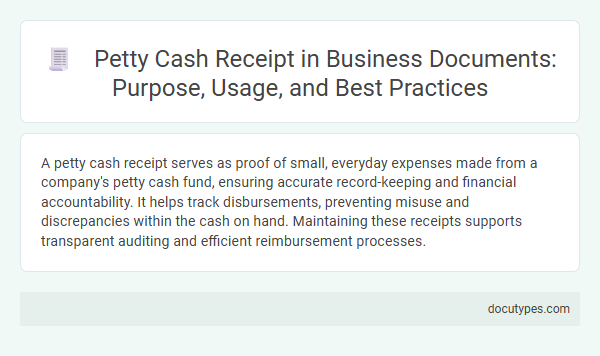A petty cash receipt serves as proof of small, everyday expenses made from a company's petty cash fund, ensuring accurate record-keeping and financial accountability. It helps track disbursements, preventing misuse and discrepancies within the cash on hand. Maintaining these receipts supports transparent auditing and efficient reimbursement processes.
Introduction to Petty Cash Receipts
Petty cash receipts serve as essential documentation for small cash transactions within a business. They provide proof of expenditure, helping to track and manage petty cash funds accurately. These receipts ensure transparency and accountability in handling minor business expenses.
Definition of Petty Cash in Business
Petty cash is a small amount of money kept on hand in a business for minor expenses. A petty cash receipt documents these small transactions to ensure accurate financial tracking.
- Definition of Petty Cash - Petty cash is a fund used for small, incidental business expenses that do not require formal purchasing processes.
- Purpose of Petty Cash Receipt - The receipt serves as proof of expenditure and helps maintain accountability for the petty cash fund.
- Business Impact - You rely on petty cash receipts to monitor spending and reconcile the petty cash balance effectively.
Purpose of Petty Cash Receipts
A petty cash receipt serves as a proof of small cash expenditures within a business or organization. Its main purpose is to document and track minor purchases, ensuring accountability and accurate financial records. You rely on these receipts to manage and reconcile your petty cash fund effectively.
Types of Expenses Covered by Petty Cash
A petty cash receipt serves as a record for small, miscellaneous business expenses paid out of a petty cash fund. It ensures accountability and accurate tracking of minor expenditures.
- Office supplies - Petty cash receipts document purchases like pens, paper, and staples needed for daily operations.
- Employee reimbursements - Small payments to employees for incurred expenses such as transportation or meals are tracked.
- Minor maintenance costs - Expenses for quick repairs or cleaning supplies are recorded with petty cash receipts.
Your petty cash receipt helps maintain transparent financial records and supports budget management for small-scale expenses.
Essential Components of a Petty Cash Receipt
What is the purpose of a petty cash receipt? A petty cash receipt serves as a formal record for small cash expenditures, ensuring accountability and accurate tracking within an organization. It helps verify that funds are used appropriately and supports financial auditing processes.
What are the essential components of a petty cash receipt? Key elements include the date of the transaction, the amount spent, and a clear description of the purchase or expense. Additional components often cover the signature of the person who received the cash and the authorization from a responsible party.
Standard Procedures for Issuing Petty Cash Receipts
A petty cash receipt serves as a documented proof of small cash transactions within an organization. It helps track expenses accurately and maintains financial transparency.
Standard procedures for issuing petty cash receipts include recording the date, amount, purpose, and the recipient's signature. This ensures accountability and simplifies the reconciliation process.
Best Practices for Managing Petty Cash Receipts
A petty cash receipt serves as a documented proof of small cash expenditures, ensuring transparency and accountability in financial transactions. Proper management of these receipts helps maintain accurate records and supports budget tracking within organizations.
- Record Every Transaction - Document each petty cash expense immediately with a receipt to prevent discrepancies and maintain clear financial trails.
- Verify Receipts Regularly - Conduct frequent audits of petty cash receipts to ensure expenses comply with company policies and prevent misuse.
- Organize Receipts Systematically - Store petty cash receipts in a dedicated, well-labeled folder or digital system for easy retrieval and efficient financial reporting.
Common Mistakes in Handling Petty Cash Receipts
| Purpose of a Petty Cash Receipt | A petty cash receipt documents small, miscellaneous expenditures made from a petty cash fund. It serves as proof of purchase, ensures accountability, and aids in accurate financial record-keeping. Receipts help verify that petty cash disbursements are legitimate and align with company policies. |
|---|---|
| Common Mistakes in Handling Petty Cash Receipts |
|
Importance of Petty Cash Receipts in Auditing
A petty cash receipt serves as proof of small, incidental expenses paid out of the petty cash fund. It provides a documented trail for every transaction, ensuring transparency and accountability.
Petty cash receipts are crucial during auditing because they verify that expenditures align with company policies and budgets. You can use these receipts to detect discrepancies, prevent fraud, and maintain accurate financial records.
What Is the Purpose of a Petty Cash Receipt? Infographic

